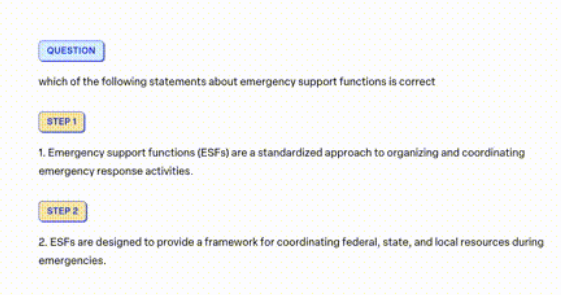
In the realm of emergency management, understanding the roles and functions of Emergency Support Functions (ESFs) is paramount. Whether you’re an emergency responder, a policymaker, or a concerned citizen, having accurate information about ESFs can make a significant difference in handling crises effectively. Let’s delve into the depths of ESFs and debunk common misconceptions to answer the question, “Which of the following statements about emergency support functions (ESFs) is correct?”
Defining Which of the following statements about emergency support functions (ESFs) is correct? (ESFs)
Emergency Support Functions, abbreviated as Which of the following statements about emergency support functions (ESFs) is correct?, are a standardized framework in the United States that facilitates the delivery of federal assistance to support state, local, tribal, and territorial response efforts during disasters or emergencies. These functions are designed to streamline coordination and resource allocation across various levels of government and private sector entities.
The Correct Statement About ESFs
Among the array of statements regarding ESFs, one holds true: ESFs are designated by the U.S. Department of Homeland Security (DHS) to address specific mission areas during emergencies. Each ESF is led by a primary federal agency with supporting agencies and organizations, ensuring a cohesive approach to disaster response and recovery. Read more
Debunking Misconceptions
ESFs Are Autonomous Entities: Contrary to common belief, ESFs do not operate independently. Instead, they function within the broader framework of the National Response Framework (NRF), collaborating closely with other ESFs and governmental agencies to provide comprehensive support.
ESFs Only Address Natural Disasters: While ESFs are often associated with natural disasters like hurricanes or earthquakes, they are equally vital during man-made crises such as terrorist attacks or pandemics. ESFs encompass a wide range of capabilities, from transportation to public health, catering to diverse emergency scenarios.
ESFs Replace Local Response Efforts: Another misconception is that ESFs supersede local response mechanisms. In reality, ESFs serve to augment and reinforce local capabilities, offering additional resources and expertise when needed while respecting the authority and autonomy of local authorities.
Importance of Understanding ESFs
Understanding the correct role and function of ESFs is crucial for effective emergency preparedness and response. By knowing how ESFs operate and collaborate within the broader emergency management framework, stakeholders can enhance coordination, allocate resources efficiently, and ultimately save lives and mitigate damages during crises. Learn more
Conclusion
In conclusion, Which of the following statements about emergency support functions (ESFs) is correct? play a pivotal role in the nation’s emergency management strategy, serving as a cornerstone for coordinated response and recovery efforts. By debunking misconceptions and clarifying their correct function, we pave the way for a more resilient and prepared society in the face of adversity. Remember, when it comes to ESFs, knowing the correct statement can make all the difference in safeguarding our communities.
FAQs
1. What are Emergency Support Functions (ESFs)?
Emergency Support Functions (ESFs) are standardized frameworks established by the U.S. Department of Homeland Security (DHS) to organize and facilitate federal assistance during emergencies or disasters. They address specific mission areas, ensuring a coordinated response across various governmental and non-governmental entities.
2. How many Emergency Support Functions (ESFs) are there?
There are a total of 15 ESFs, each designated to address different aspects of emergency response and recovery. These range from transportation and public health to logistics and mass care, among others.
3. Who leads each Emergency Support Function (ESF)?
Each ESF is led by a primary federal agency responsible for coordinating resources and efforts within its designated mission area. These agencies work in collaboration with supporting agencies and organizations to fulfill the objectives outlined in the National Response Framework (NRF).
4. How do Emergency Support Functions (ESFs) operate during emergencies?
During emergencies, ESFs activate based on the nature and severity of the event. The lead federal agency of the affected ESF coordinates with state, local, tribal, territorial, and private sector partners to assess needs, allocate resources, and support response and recovery efforts on the ground.
5. Are Emergency Support Functions (ESFs) only applicable to natural disasters?
No, ESFs are designed to address a wide range of emergencies, including natural disasters, man-made incidents, and public health emergencies. They provide a flexible framework that can adapt to various types of crises, ensuring a comprehensive and coordinated response.
6. How do Emergency Support Functions (ESFs) interact with local response efforts?
ESFs are designed to complement and support local response efforts rather than replace them. While ESFs provide additional resources, expertise, and coordination at the federal level, they work in tandem with local authorities to enhance overall response capabilities and address the needs of affected communities.
7. Where can I find more information about specific Emergency Support Functions (ESFs)?
For more detailed information about each ESF, including their roles, responsibilities, and coordination mechanisms, you can refer to the official documentation provided by the U.S. Department of Homeland Security (DHS) or consult with relevant federal agencies involved in emergency management.
